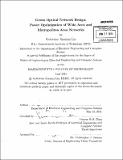Green optical network design : power optimization of wide area and metropolitan area networks
Author(s)
Lin, Katherine Xiaoyan
DownloadFull printable version (13.30Mb)
Other Contributors
Massachusetts Institute of Technology. Dept. of Electrical Engineering and Computer Science.
Advisor
Vincent W.S. Chan.
Terms of use
Metadata
Show full item recordAbstract
Advancements in technology are fueling huge growth in network traffic capacity. Demand for low cost, reliable, and high bitrate transmissions grows 40-110% internationally every year. To date, most research has focused on cost minimization of wide area and metropolitan area networks. In this thesis, we concentrate instead on finding scalable WAN designs with respect to power constraints and optimal MAN topologies with minimal capital and operating expenditures. We find optical bypass networks to be most scalable with respect to power consumption, especially when quality of service and network flexibility, reliability, and protection are considered. The power consumption of the standard bypass network can be lowered further through a hybrid design in which whole wavelengths of core, stable traffic between node pairs are routed via direct, fixed lightpaths using patch panelling and unexpected, bursty traffic is switched on a standard optical bypass network. We analyze power distribution among components and find the OXC switch most scalable at each node and O/E/O switches and routers wasteful. Finally, we prove that shortest path and minimum hop routing is power optimal and traffic balanced routing should be avoided. We approximate MAN topologies with regular graphs for tractable analysis. We augment a previous cost-based joint optimization formulation [13] with power expenditure modelling and obtain closed form solutions for optimal node degree and normalized network costs. We find that the optimal node connectivity increases 20-25% due to the added operating expenditures. Normalized network cost and normalized network cost per unit traffic also rise by approximately 25%. Our results show that the Generalized Moore graph with node degree between 0.05N and 0.08N is both power and cost minimal for a purely optical network.
Description
Thesis (M. Eng.)--Massachusetts Institute of Technology, Dept. of Electrical Engineering and Computer Science, 2011. Cataloged from PDF version of thesis. Includes bibliographical references (p. 133-134).
Date issued
2011Department
Massachusetts Institute of Technology. Department of Electrical Engineering and Computer SciencePublisher
Massachusetts Institute of Technology
Keywords
Electrical Engineering and Computer Science.